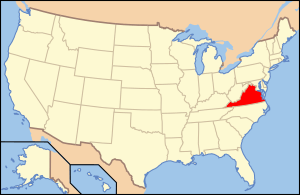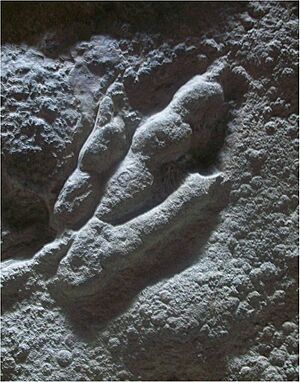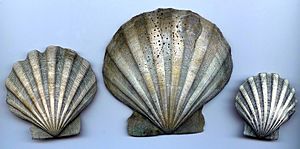Paleontology in Virginia facts for kids

Paleontology in Virginia is all about finding and studying fossils in the state of Virginia. These fossils tell us amazing stories about what Virginia was like millions of years ago! From ancient seas to swampy forests, Virginia has been home to many different kinds of plants and animals.
Virginia's rocks hold clues from the Cambrian Period all the way to the Quaternary Period. Long, long ago, during the early Paleozoic Era, Virginia was covered by a warm, shallow sea. This sea was full of creatures like brachiopods (shellfish), bryozoans (tiny colonial animals), corals, and nautiloids (shelled relatives of squid). The land briefly rose out of the sea during the Ordovician Period, but by the Silurian Period, it was underwater again. During this time, more brachiopods, trilobites, and even entire reefs thrived. Later, in the Carboniferous Period, Virginia slowly turned into a big, wet swamp.
When the Triassic Period arrived, Virginia was covered in plants like horsetails and tall trees. Dinosaurs walked here, leaving behind their bones and footprints. Many fish from ancient lakes were preserved during the Jurassic Period. The sea returned to Virginia during the Cretaceous Period, bringing belemnites (ancient squid-like creatures) and corals. Sea levels changed a lot during the Cenozoic Era. Fossils of sea animals, sharks, and whales from this time have been found. During the last Ice Age, huge mastodons roamed Virginia. In the late 1700s, Thomas Jefferson became interested in local fossils. Later, in the 1920s, dinosaur tracks were found at Oak Hill. Today, the scallop Chesapecten jeffersonius is Virginia's official state fossil.
Contents
Ancient Life in Virginia
Life in the Paleozoic Era
No fossils from the very oldest time, the Precambrian, have been found in Virginia. But the state's fossil record starts with the Cambrian Period. During the Cambrian, Virginia was covered by a warm, shallow sea. Not many fossils from this time have been found, but scientists have discovered at least 17 types of nautiloids from the time when the Cambrian ended and the Ordovician Period began. Many of these nautiloids were similar to those found in nearby states.
During the Ordovician, tiny creatures called graptolites were preserved in the mud that later became Virginia's shale rocks, especially in Augusta County. Other Ordovician sea life found in Scott County included brachiopods, bryozoans, corals, echinoderms (like starfish), and sponges. Virginia was underwater for the first part of the Ordovician, but then the land rose up during an event called the Taconic uplift.
The sea returned to Virginia during the Silurian Period. Scientists have found Silurian brachiopods near Gate City at a place called Big Moccasin Gap.
In the Devonian Period, mountains began to form again in Virginia. Many types of Devonian brachiopods have been found in places like Bull Pasture Mountain, Frederick County, and Shenandoah County. Some of the brachiopods found in Shenandoah County were unusually large! Corals were also preserved at Bull Pasture Mountain. Bryozoans were found at Bull Pasture Mountain and Peters Hill. Crinoids (sea lilies) and ostracods (tiny crustaceans) were preserved in Frederick County. Trilobites, another type of ancient sea creature, were also found in Frederick County. A diverse fossil reef was even discovered in a cemetery in Clifton Forge. Shenandoah County also holds many other kinds of ancient life besides its big brachiopods.
During the Mississippian Period, algae and brachiopods were preserved south of Gate City and in Washington County. Corals, crinoids, and gastropods (snails) were also found south of Gate City. Tiny ostracods were preserved in Bland County. Pelecypods (clams) were found in Bland and Washington Counties. From the late Mississippian through the Pennsylvanian Period, Virginia became a giant swamp. The many plants that grew here left behind lots of fossils in the rocks. Plant fossils from this time have been found in Montgomery, Alleghany, Wise, Dickenson, and Buchanan counties. After this, the sea began to move away from Virginia.
Life in the Mesozoic Era
During the Triassic Period, central Virginia was a deep valley where the land was pulling apart. Brachiopods were still living in Virginia during the Mesozoic Era. On land, the early Mesozoic plants in Virginia included horsetails, gymnosperms, cycads, and conifers (like pine trees). These plants were very similar to those found in North Carolina at the same time. Huge fossil trees called Araucarioxylon were also present.
Dinosaurs lived in Virginia and left so many footprints at the Culpeper Stone Quarry near Stevensburg that it's been compared to a "ballroom" of tracks! Another fossil site from this time, the Solite Quarry, is right on the border between Virginia and North Carolina. Many other animals, like crocodilians, phytosaurs (ancient crocodile-like reptiles), and lizard-like creatures, also left their footprints there.
The Solite Quarry is most famous for its fossil insects. It's the only place in the world where complete, well-preserved Triassic insects have been found. The oldest known examples of many living insect groups have been discovered here. Insects from the Solite Quarry include staphylinid beetles, caddisflies, belostomatids (giant water bugs), and thrips. Fossil insects are also common in other parts of Virginia. Small insect fossils were often found with many conchostracans (small clam-like crustaceans).
Near the North Carolina border, at Leaksville Junction, dinosaur footprints have been found in the Late Triassic Cow Branch Formation. These might be the oldest dinosaur tracks in the eastern United States. Footprints from meat-eating dinosaurs called Grallator and many footprints from plant-eating dinosaurs called Atreipus have been found here. Other fossils include remains of the phytosaur Rutiodon and the lizard-like Tanytrachelos.
At least three fossil sites for the Late Triassic Manassas Sandstone have been found in Fairfax County, Virginia. Dinosaur tracks of the Grallator type have been reported from this rock layer. Also found are tracks from other archosaurs (a group that includes dinosaurs and crocodiles) like Apatopus, Brachychirotherium, and Chirotherium. Body fossils of fish and the phytosaur Rutiodon have also been found.
The Late Triassic dinosaur footprints in the Balls Bluff Sandstone are so numerous and well-preserved that this rock layer is considered one of the best places in the world to find these fossils. Near Culpeper, the Balls Bluff Sandstone has yielded tracks from the plant-eating dinosaur Gregaripus, the long-necked dinosaur Agrestipus, and the meat-eating dinosaurs Grallator and Kayentapus. Tracks from aetosaurs (armored reptiles) have also been found in the Balls Bluff near Culpeper. One Grallator track from the Balls Bluff was found near Manassas National Battlefield.
For about 30 million years, from the end of the Late Triassic to the beginning of the Early Jurassic, the Culpeper basin was a very large lake. A wide variety of fish lived in what is now Virginia during the Early Jurassic. The best-preserved fish fossils were semionotids. Other fish found in Early Jurassic Virginia included coelacanths and palaeoniscids. Their fossils were buried in a place now called the Midland Fish Bed. During the Cretaceous Period, eastern Virginia was covered by seawater. This sea was home to belemnites and oysters.
Life in the Cenozoic Era
Sea levels in Virginia rose and fell a lot during the Tertiary Period of the Cenozoic Era. During the Eocene Epoch, gastropods and pelecypods were preserved in Westmoreland County. Tiny single-celled organisms called foraminiferans were preserved in James City County. In the Miocene Epoch, gastropods and pelecypods were found in York and James City Counties. Miocene vertebrates (animals with backbones) in Virginia included sharks and whales, which left their teeth and bones in York County. During the Quaternary Period, large mastodons were preserved near bodies of water in Virginia.
Fossil Discoveries in Virginia's History
In 1782, workers digging in a swamp found some very large bones and teeth. Major Arthur Campbell sent them to Thomas Jefferson, who was a very curious scholar. Jefferson wrote in a letter that several African slaves who saw the fossils said they looked like elephant remains. The fact that the slaves identified the teeth as elephant-like suggests that these were mammoth fossils, not mastodons, because mammoth teeth are more similar to elephants'. Between 1775 and 1780, Thomas Jefferson also talked with leaders of the Delaware Indians in Virginia about the famous fossils from Big Bone Lick in what is now Kentucky.
Around 1920, Early Jurassic dinosaur tracks were found at Oak Hill. This happened during renovations when sandstone was being dug up for terraces and walkways. Later, in 1956, a scientific paper reported finding 17 types of nautiloids from 10 different groups in a rock layer that marked the change from the Cambrian to the Ordovician periods in Virginia. Two of these groups were completely new to science! The scientists also noted that many of these nautiloids were similar to those found in nearby states. In the 1980s, the Midland Fish Bed, a very important site for Early Jurassic fish fossils, was flooded during the building of a dam. Before it was flooded, it was considered one of the best places to find fish fossils in Virginia, including semionotids, palaeoniscids, and coelacanths. In 1993, the scallop Chesapecten jeffersonius was officially named the Virginia state fossil.
Natural History Museums
If you're interested in seeing fossils and learning more about Virginia's natural history, you can visit these museums:
- Hostetter Museum of Natural History, Suter Science Center, Eastern Mennonite University, Harrisonburg
- James Madison University Mineral Museum, Harrisonburg
- Museum of the Middle Appalachians, Saltville
- Virginia Museum of Natural History, Martinsville
- Virginia Tech Geosciences Museum, Blacksburg



